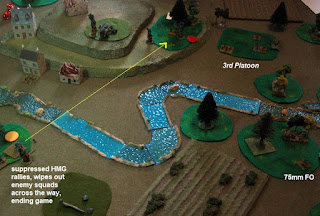We played my in-process Camden scenario again Saturday, with a few tweaks to simplify the game. Rules are the in-process AWI mods to the Bloody Big Battle rules. I took the part of Horatio Gates, commanding all the militia and a couple fragile Continental units. Carl played De Kalb (who is rated as a hero) with two Continental "brigades", one of veteran Maryland and Delaware troops. Andrew was Cornwallis, commanding Webster’s right flank brigade of aggressive, veteran troops and the reserve of the 71st Highlanders and Tarleton’s dragoons. The Rebel militia starts the game disrupted due to the order for them to attack the redcoats having been very poorly received. Per usual BBB, Gates didn't rate being represented since he was so uninspiring at this battle.
Purists will note that Tarleton’s horse are actually British Light Dragoons. All I can say is the manufacturer (Frying Pan & Blanket) didn’t make Tarleton’s lads. There are other substitutions, though the 23rd, 33rd and 71st and some American units are all proper. Yes, the 23rd are wearing their bearskin hats in the deep South summer. They’re my toys. If I hit the lottery, I’ll do the set over in 15mm with Blue Moon figures. The odds are about the same as being hit by lightning while attacked by a shark.
Webster (Andrew) charged, being met by my truly wimpy defensive fire dice. The 23rd Foot defeated the Virginia militia opposing them and then exploited and beat the light infantry. The caption on the photo below is incomplete. The 33rd charged and shoved the other Virginia militia back. Rawdon (Jay) on the Crown left fell back, razzed by Cornwallis (Andrew). Jay had played De Kalb in the previous game and had a healthy respect for veteran Continentals led by a hero.
The Light Infantry rallied and returned to trade fire with the regulars. The North Carolina militia advanced, pouring withering into the 71st, getting two hits and going low on ammo. The British grasshopper guns silenced their American counterparts. Armand’s dragoons went on a long loop around the British right and seem to have got lost for a couple turns after that. The North Carolina militia, low on ammo, charged the shot-up 71st and managed to get a tie. Each side lost a stand. Any unit reduced to a single stand is removed, and so the 71st disappeared, leaving a gaping hole in the British center.
(That's not VA militia below, that's the beat-up Light Infantry)
Tarleton charged, riding down the
silenced light guns. The 33rd charged, defeating the Virginia
militia before them. The 23rd stalled, engaged in an indecisive firefight
with the militia opposite them. Rawdon’s troops formed an inverted V shape,
with field guns at the apex. It was designed to get flanking fire on at least
one of the enemy units that advanced into it. It worked.
Both North Carolina militia units got decent movement rolls and advanced into the gap in the British lines. One flanked Tarleton and the other flanked Rawdon’s force. Effective fire decimated the dragoons. Rawdon took hits too.
The 33rd foot beat the remains of the Virginia militia facing them and chased them off the table. They exploited into the American baggage, looted it and then set it afire. Armand’s dragoons awaked from their slumber, tentatively threatening the rear of the 23rd, who were still engaged in a desultory firefight with the thoroughly trashed Light Infantry. On the other flank, the trained 2nd Maryland brigade dissolved under fire. The veteran 1st was about to go under too. But Rawdon’s Irish Volunteers were spent, hiding behind the Loyalist North Carolina militia, who melted away under flanking fire. Since there’s no breaking point on these armies, it looked like we could go on to the last man standing. We’d played four turns in a tad over two hours. And decided to call it a game. There had been a bit of trash-talking. Entertaining but slow.
My revised, simplified
victory conditions had each stand a spent unit started with count one victory
point to the enemy, two if the unit was removed from the table. So a 5-base
spent unit would count 5 points, 10 if off the table. Yes, militia counted the same
as veterans. Obviously, room for improvement here. The British won 57 points to
29, a substantial victory, almost decisive (2-1). If the hole hadn’t been
exploited it would likely have been decisive. Or if Tarleton’s dragoons hadn’t
been taking selfies or whatever they doing around the captured guns. On the one
hand, the British beat the Yanks handily, which is what I figure should be the
result of this battle given the historical deployment on the veteran British
right facing the large but unsteady Rebel left. I still think the militia was
too resilient. The thinking cap needs to be put on again. That’s it for
Fencible games for a while as I head up north with my wife for a month. Any
further posts in that time, if any, will be historical pondering but no
after-action-reports. May all your wars be little ones. Stay away from the real ones.























